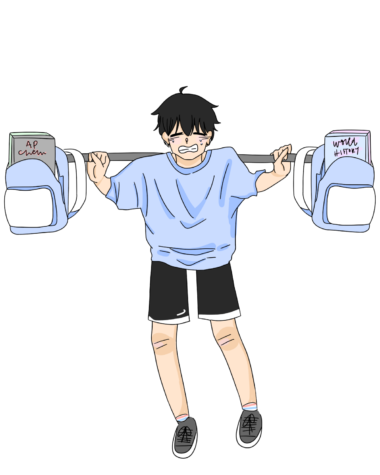Benching Backpacks
September 16, 2022

An ongoing competition has been sweeping Westview students into a frenzy, almost as long as this school has been around. No, it’s not senior assassin. We have all seen students plop down into their chairs saying, “I swear, my backpack feels like it’s filled with rocks” and their friend is like ‘Hah, you should feel mine.” They then trade backpacks and depending on whether or not their friend is taking an AP class, their spines promptly shatter due to the astounding weight of textbooks that they’ve been carrying around.
The reality that school will start hits as soon as you are handed that mountain of textbooks on Registration Day. These textbooks weigh somewhere in the neighborhood of a metric ton, and combined with Chromebooks and notebooks, create a weight that causes that signature slouch that is so present in teens.
“Sit up straight,” they say. “Do well in school,” they say (without realizing that these things are mutually exclusive). There is legitimate research out there that shows how strapping heavy weights to our torsos can cause problems with our shoulders, backs, and necks.
According to the Southwest Scoliosis and Spine Institute, “A child’s backpack should not weigh more than 10% to 15% percent of the child’s body weight.”
At the same time, however, according to a Consumer Reports survey, an average student’s backpack weighs about 12 to 20 pounds, which is about 15% to 30% of an average students’ body weight. The AVERAGE weight of a backpack is the maximum weight that a student can carry continuously without having lasting effects.
Looks like we don’t need those new weights in the fitness lab after all, just put some junior’s backpacks onto the bar, and you’re good to go.
While this problem may feel pervasive, a simple solution exists. Almost every single textbook can be found online. Millions of textbooks can be packed in a 2-3 pound square that we are all already carrying around, so why not use it? Give my aching vertebrae a break!
The model of Chromebook that is given to most Westview students costs about $127. The AP Gov textbook that Westview uses costs $113.45. Multiply that by two, or maybe three, and the school has already spent much more money (per year) than they would if they just got textbooks online.
During quarantine, schools all across the globe started to shift toward more online learning. Now, in the U.S., 60% of schools K-12 incorporate chromebooks into their curriculum. Classes were able to access the latest news much more easily; instead of having to flip through a 1500 page textbook from 1995, students could follow a link to a short PDF.
Lots of textbooks at Westview are at least somewhat outdated. The AP Gov textbook, for example, is from 2004. So many things have happened to our government in the 18 years since then. For this reason, the AP Gov class is working on exchanging and updating their textbook to an online PDF, and the rest of the school’s courses should follow their example.
Online, updated textbooks are usually readily available, as it takes less work and expense to edit a PDF, than to edit a book, print new copies, and distribute them to schools across the country.
I understand that when reading from a paper textbook, some students may be able to absorb the material more easily, but if the material itself is outdated, what’s the point? If students are reading their textbooks from a hospital bed, with a fractured spine, the material might be a bit difficult to absorb either way.
Please, for the love of vertebrae, use the online versions of textbooks. Our backs will thank you.



V0X • Sep 16, 2022 at 10:53 am
I am… very confused as to how the math works for the backpacks, and the percentage of body weight thing. If we just take the high end estimate of 20 pounds, and assume that those 20 pounds are 30% of a supposed student’s body weight, we’re looking at a 68 pound individual. Color me unconvinced. And even if we highballed it, a 20 pound backpack accounting for 15% bodyweight would be about 133 pounds, which isn’t even that low of a weight threshold all things considered.
Rudimentary math aside, I’m not totally convinced that the possibility of updating textbooks is the best reason for ditching physical books. There are probably a lot of subjects, or parts of subjects out there, that honestly don’t require updating. Take AP Gov. I somehow doubt that the view of Federalism has changed immensely over the past couple years. Of course, there are probably some minor improvements here and there that could be made over time, but I don’t think it’s the most compelling argument out there. Neither is the weight of the textbooks, considering that most classes tend not to require kids to bring their textbooks, with a few exceptions. Honestly, (relative) accessibility and cost (no way online textbooks also sell for a hundred books, right?) would probably be more relevant. I’m personally biased towards online books, so +1 nevertheless :p